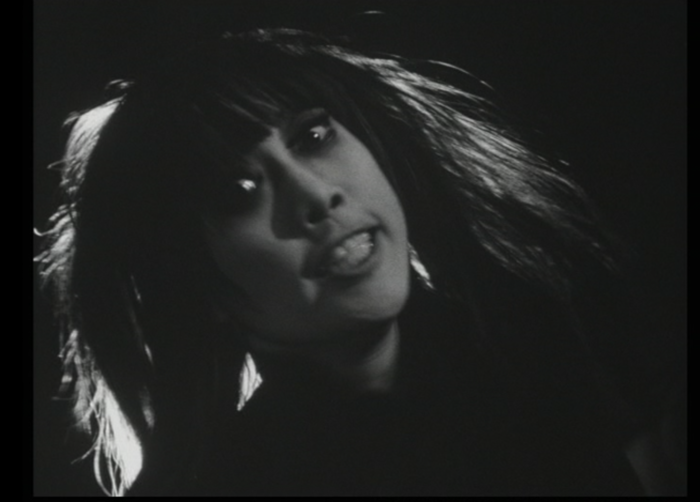English title: Nanami – The Inferno of First Love
1969: Directed by Susumu Hani; screenplay by Shuji Terayama and Susumu Hani – or just by Susumu Hani, or just by Shuji Terayama, depending on who you believe.
“What’s left when you peel a cabbage? The heart. So what’s left when you peel an onion?”
To find the answer to this children’s riddle, you have to enter a mini-maelstrom of loneliness, despair, sadism, paedophilia, hypocrisy, deceit and doomed innocence. The film is disturbing, but also quite funny.
It was made under the auspices of A.T.G (Art Theatre Guild), an indie production outfit that backed a number of challenging films in the 1960s and 1970s, including Terayama’s first two feature films.
In recent years, director Susumu Hani, still hale and hearty at the age of ninety, has claimed in panel discussions and interviews that Terayama contributed nothing to the script; the joint writing credit was there simply to drum up publicity for the film.
On the other hand, Terayama himself writes in the sleeve notes to the “soundtrack album” (more of that later) that the film was “directed by Susumu Hani, with screenplay by Shuji Terayama.”
Fifty years on, nobody can know the exact nature of the interaction between the two men, but the evidence of the film itself is fairly clear. It is nothing like Hani’s other films, which are mostly in a bleak cinéma vérité style; indeed, soon afterwards Hani gave up feature films altogether and became a documentary maker.
First Love: The Hell Version is, however, replete with Terayama’s characteristic creativity and wit, as well as themes often present in his prose writings of the 1960s.
Examples are the male protagonist from Tohoku, Terayama’s native region: the lustful mother who likes to kiss her young son full on the mouth, then abandons him and runs off with a boxer; the laughter lessons the gloomy youngster is made to take; the masked children playing in the graveyard; the Monty Python-esque naked ramen man: the surreal dialogue.
“You have a wife, don’t you?”
“Yes, she’s as cold as ice. When she’s asleep, I often dream of setting her on fire.”
Much of this foreshadows Terayama’s films of the 1970s.
Terayama clearly felt that he had ownership of the project. He appears in person in the trailer, firing out disorienting questions in an empty cinema.
The publicity poster for the film was by Akira Uno, a Terayama associate who designed many of the posters for his Tenjo Sajiki theatre troupe. The title, with its echoes of Dante and Rimbaud, could only have been dreamed up by Terayama, who was obsessed with depictions of the torments of hell found on the walls of obscure Buddhist temples.
Then there is the extraordinary First Love: The Hell Version LP record that Terayama issued on his Tenjo Sajiki label shortly after the film was released.
As might be expected from a Terayama production, the album contains none of the music that Toru Takemitsu composed for the film, nor any of the contemporary pop songs used as incidental music.
Instead, it features short spoken word monologues and dialogues and a bevy of songs – one entitled Season in Hell in a direct reference to Rimbaud. All material, spoken word text and song lyrics, was written by Terayama.
The songs were sung by, amongst others, rising stars Carmen Maki and folksinger-cum-banker Kei Ogura, both members of Terayama’s Tenjo Sajiki team at the time. Most of the spoken word segments are voiced by the two rookie actors who played the lead roles in the film, Kuniko Ishii and Akio Takahashi.
Interest was piqued by the fact that they had apparently become an item during the filming. The jacket featured several photos of the two youngsters naked, as well as some of Terayama’s best-known tanka poems, his notes about the making of the record and the riddle about the vegetables, which is repeated several times in the film.
“What’s left when you peel a cabbage? The heart. So what’s left when you peel an onion?”

Here is the album cover, with photos of the young lovers by Kishin Shinoyama, later to photograph John Lennon and Yoko Ono for the Double Fantasy cover.
The last track on the album is the strangest. It features a collage of voices – apparently one hundred and twenty altogether – shouting out the names of their first loves and anything else that comes to mind.
Most of the shouters are ordinary citizens who have applied to participate, but sprinkled amongst them are various Terayama-related celebrities, ranging from film director Masahiro Shinoda to kabuki star Kichiemon Nakamura, from professional wrestler Giant Baba to Eiko Kujo, Terayama’s wife at the time.
Audience, or listener, participation was a key part of Terayama’s aesthetic. He wanted to break down the barriers between the producers and consumers of art. The culmination of this approach was the extraordinary Knock project, in which entire towns were used as performance spaces and bizarrely-attired Tenjo Sajiki members would knock on the doors of ordinary citizens and invite themselves into their homes. On several occasions the police were called.
Rather than being disengaged, as Hani suggests, Terayama was clearly inspired by First Love: The Hell Version and sought to extend it well beyond the confines of the cinema screen.
As for the children’s riddle, the answer is totally logical. When you peel an onion, what could be left other than “tears”?



